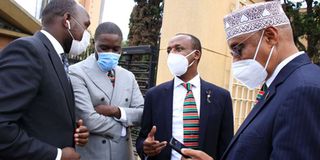Premium
Let’s adopt revenue report, senators say

Senators outside parliament on August 4, 2020 after debate on revenue sharing was adjourned.
What you need to know:
- The lawmakers say the formula, if adopted, should be implemented in a two-year phased period.
- The figure to cushion should be pegged at 10 per cent of the Sh316.5 baseline, they say.
- The senators want the first Sh316.5 billion shared using the second generation formula.
Senators allied to President Uhuru Kenyatta and Orange Democratic Movement leader Raila Odinga now want the proposal by a House Finance committee used as the basis of sharing county revenue.
The proposal provides for a 10-parameter formula, with the biggest weight placed on health and basic share both at 20 per cent, population (16 per cent), agriculture (12 per cent), poverty (14 per cent), land area (five per cent), urban area (four per cent), roads (seven per cent), fiscal prudence and fiscal effort both weighted at one per cent.
“The formula should be implemented in a phased manner to avoid disrupting county plans and budgets,” says a policy brief seen by the Nation.
The brief was handed to the House leadership and is likely to form part of the debate once the Senate resumes sittings on Tuesday.
Phased period
The lawmakers say the formula, if adopted, should be implemented in a two-year phased period, sets Sh316.5 billion as baseline, declares that no county should lose more than 10 per cent of its previous allocations and that devolved governments whose revenue is bound to reduce should be cushioned from the third financial year.
The figure to cushion should be pegged at 10 per cent of the Sh316.5 baseline, they say.
“If this is adopted, there will neither be a loser nor a winner as every county will get the exact allocation received in the 2019/20 financial year,” the brief reads.
According to the proposal, the allocation this financial year should be based on the second generation formula and the 2009 population data.
The National Treasury projects that equitable share to counties will stand at Sh325 billion in the 2021/22 financial year.
Second generation formula
The senators want the first Sh316.5 billion shared using the second generation formula and the 2009 population data while the balance of Sh9 billion should be subjected on the third generation formula.
The two-year moratorium would have lapsed in the 2022/23 financial year and the third generation formula would have come into operation.
Treasury projects that the equitable share would have risen to Sh331 billion by then.
The group proposes that the third generation formula should apply fully, complete with the 2019 population census data at this stage.
Simulations developed by the senators show that 16 counties could experience a reduction in money from the equitable share. They say 10 per cent cushion fund will be applied at this stage.
Committee failed to agree
It has emerged that the 12-member committee failed to agree because of the dispute over which data to use when sharing the revenue.
Counties from northern Kenya want the 2009 population data used while the one-man, one-shilling team prefers the August 2019 population census.
It is on the basis of these concerns that the one-man, one-shilling team wants the Commission on Revenue Allocation to validate the accuracy and relevance of data used and review completeness of the parameters especially on road, health, agriculture, fiscal prudence and responsibility.
The team says data by the Kenya Roads Board has errors since it is based on the 2009 census.
The data, for instance, shows Mandera has 1.16 million people without access to roads against a total population of 867,457.
The team also argues that data on agriculture based on rural households is contentious because it does not take into account fishing and pastoralism.
Speaker Kenneth Lusaka Tuesday said the Senate committee formed develop consensus on the formula would hold a meeting with the House leadership Wednesday, as he pushed the debate to next week.





